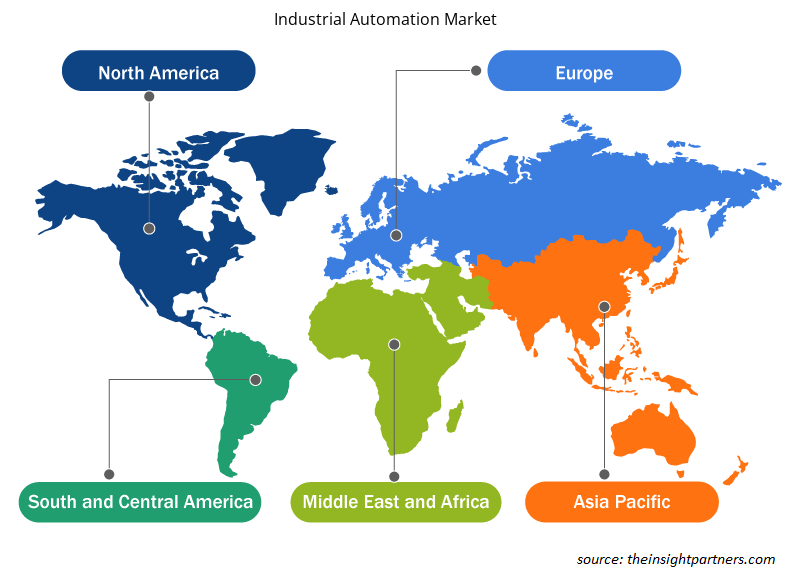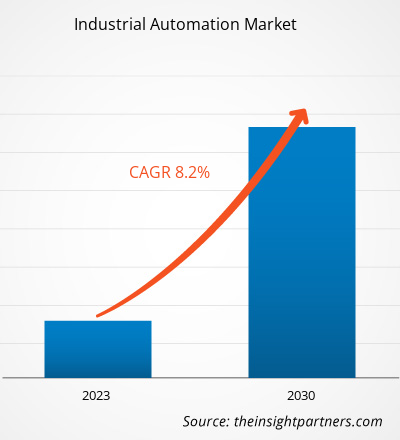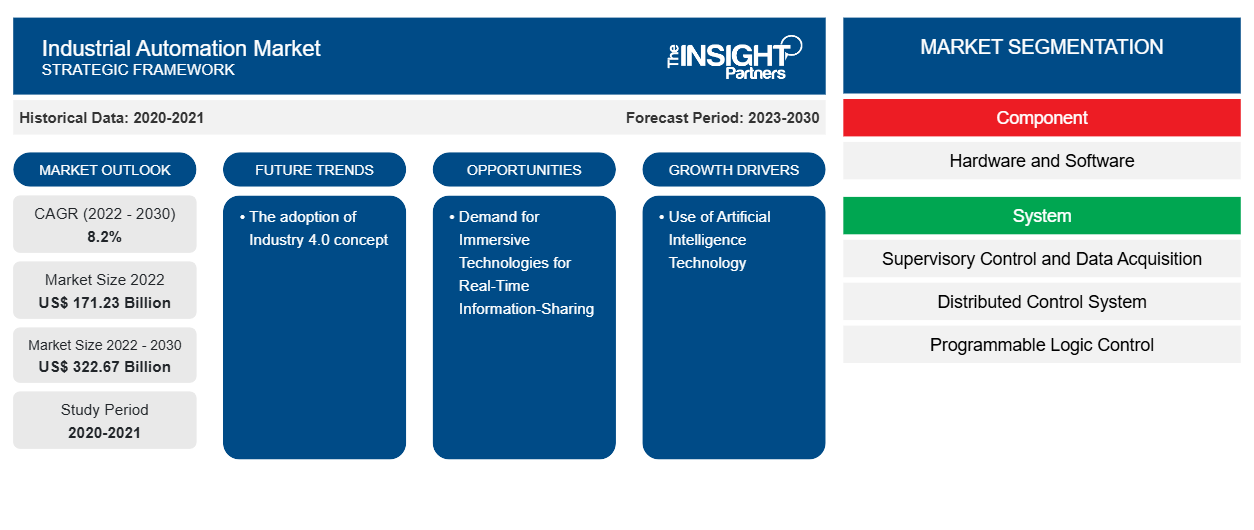Se prevé que el tamaño del mercado de la automatización industrial alcance los 322.670 millones de dólares en 2030, frente a los 171.230 millones de dólares en 2022. Se espera que el mercado registre una CAGR del 8,2 % durante el período 2022-2030. Es probable que la adopción del concepto de Industria 4.0 siga siendo una tendencia clave en el mercado.
Análisis del mercado de automatización industrial
El uso de la tecnología de inteligencia artificial, las empresas conectadas emergentes y el enfoque en la eficiencia operativa están impulsando el mercado. Se prevé que el mercado crezca durante el período de pronóstico debido a las iniciativas favorables adoptadas por el gobierno para promover la automatización industrial. Además, la demanda de tecnologías inmersivas para compartir información en tiempo real y la integración de sistemas de visión artificial con tecnologías de aprendizaje profundo están creando oportunidades lucrativas para el mercado.
Descripción general del mercado de automatización industrial
La automatización industrial reemplaza la intervención humana mediante el uso de sistemas de control como robots, computadoras y tecnología de la información para operar varias maquinarias en una industria. Dependiendo de las operaciones involucradas, los sistemas de control de automatización industrial se dividen en dos categorías: automatización de plantas de proceso y automatización de fabricación. La automatización industrial mejora la calidad, confiabilidad y tasa de producción del producto, al mismo tiempo que reduce los costos de fabricación y diseño mediante el uso de tecnologías y servicios nuevos, innovadores e integrados. Tienen una variedad de características, que incluyen alta productividad, calidad, flexibilidad y exactitud de la información, que se proyecta que promoverán el uso de la automatización en el sector industrial durante el período de pronóstico. Además, el aumento en la adopción de soluciones de automatización en petróleo y gas, fabricación, productos químicos y materiales, productos farmacéuticos y otras industrias está impulsando la automatización industrial.
Personalice este informe según sus necesidades
Obtendrá personalización en cualquier informe, sin cargo, incluidas partes de este informe o análisis a nivel de país, paquete de datos de Excel, así como también grandes ofertas y descuentos para empresas emergentes y universidades.
-
Obtenga las principales tendencias clave del mercado de este informe.Esta muestra GRATUITA incluirá análisis de datos, desde tendencias del mercado hasta estimaciones y pronósticos.
Factores impulsores y oportunidades del mercado de la automatización industrial
Uso de Tecnología de Inteligencia Artificial para Favorecer el Mercado
La inteligencia artificial (IA) está transformando la fabricación de maneras increíbles. La IA permite que las máquinas aprendan, se adapten y tomen decisiones de forma autónoma. Los fabricantes utilizan la tecnología para descubrir patrones y anomalías de activos con el fin de optimizar la producción y ahorrar tiempo de inactividad. Por ejemplo, la incorporación de IA en robots industriales y drones mejora la precisión y ayuda en actividades como la inspección, el mantenimiento y la manipulación de materiales. Esto reduce la necesidad de intervención humana, reduce el peligro de accidentes, aumenta la eficiencia del mantenimiento y extiende la vida útil del equipo. Además, los ingenieros de tecnología de operaciones (OT) que están familiarizados con las operaciones y los equipos utilizan cada vez más tecnologías de IA sofisticadas con interfaces de usuario (UI) visuales y de apuntar y hacer clic. La disponibilidad de aplicaciones de aprendizaje automático (ML) prediseñadas y la demanda industrial de automatización están impulsando el mercado.prebuilt machine learning (ML) apps and industrial demand for automation is fueling the market.
Demanda de tecnologías inmersivas para compartir información en tiempo real
La realidad virtual (RV) y la realidad aumentada (RA) son tecnologías inmersivas que permiten compartir información en tiempo real para ayudar a la capacitación de los trabajadores, eliminar errores humanos y mejorar el rendimiento. Esto implica que la RV y la RA pueden agregar un valor comercial significativo al mejorar la seguridad de los trabajadores, aumentar la productividad y reducir el tiempo de inactividad. La RA puede ayudar a las empresas industriales al facilitar medidas de regreso al trabajo, como la colaboración remota, la asistencia remota, las instrucciones de trabajo aumentadas y la capacitación en 3D. La RA también está ayudando con estrategias de futuro del trabajo a largo plazo destinadas a cerrar la brecha de habilidades e impulsar ganancias significativas. La realidad aumentada está adquiriendo cada vez más importancia en el lugar de trabajo.VR) and augmented reality (AR) are immersive technologies that enable real-time information sharing to aid worker training, eliminate human errors, and boost performance. That implies VR and AR may add significant commercial value by improving worker safety, increasing productivity, and reducing downtime.
- Transmita datos de sensores y de Internet industrial de las cosas (IIoT) para mejorar el monitoreo de condiciones, la resolución de problemas y las reparaciones.IIoT) and sensor data to improve condition monitoring, troubleshooting, and repairs.
- Vea instrucciones de trabajo inmersivas en 3D para procedimientos de ensamblaje, inspección y mantenimiento.
- Obtenga orientación paso a paso y asistencia a pedido de profesionales experimentados.
- Transmiten comentarios sobre las circunstancias que observan en la fábrica o en el campo al hilo digital conectado, lo que permite una retroalimentación de circuito cerrado en toda la empresa.
Los operadores y técnicos de servicio utilizan una realidad aumentada altamente exigente para agilizar los procesos operativos.
Análisis de segmentación del informe de mercado de automatización industrial
Los segmentos clave que contribuyeron a la derivación del análisis del mercado de automatización industrial son el componente, el sistema y el usuario final.
- Según los componentes, el mercado de la automatización industrial se divide en hardware y software. El segmento de hardware tuvo una mayor participación de mercado en 2022.
- Por sistema, el mercado se segmenta en control de supervisión y adquisición de datos, sistemas de control distribuido, control lógico programable y otros. Se prevé que el segmento de control de supervisión y adquisición de datos se expanda durante el período de pronóstico.
- Según los usuarios finales, el mercado se divide en petróleo y gas, automoción, alimentos y bebidas, productos químicos y materiales, aeroespacial y defensa, entre otros. El segmento de petróleo y gas tuvo una mayor participación de mercado en 2022.
Análisis de la cuota de mercado de la automatización industrial por geografía
El alcance geográfico del informe del mercado de automatización industrial se divide principalmente en cinco regiones: América del Norte, Asia Pacífico, Europa, Medio Oriente y África, y América del Sur y Central.
Se prevé que el mercado de Asia Pacífico se expanda durante el período de pronóstico debido a la presencia de actores clave. Omron Corporation, Mitsubishi Electric Corporation, Hitachi Ltd. y otros están ofreciendo a sus clientes productos de automatización de fábrica tecnológicamente avanzados que mejoran sus eficiencias operativas. La expansión de las industrias y la creciente adopción de tecnologías de automatización industrial están impulsando el mercado.
Perspectivas regionales del mercado de automatización industrial
Los analistas de Insight Partners explicaron en detalle las tendencias y los factores regionales que influyen en el mercado de automatización industrial durante el período de pronóstico. Esta sección también analiza los segmentos y la geografía del mercado de automatización industrial en América del Norte, Europa, Asia Pacífico, Oriente Medio y África, y América del Sur y Central.

- Obtenga datos regionales específicos para el mercado de automatización industrial
Alcance del informe de mercado de automatización industrial
| Atributo del informe | Detalles |
|---|---|
| Tamaño del mercado en 2022 | US$ 171,23 mil millones |
| Tamaño del mercado en 2030 | US$ 322,67 mil millones |
| CAGR global (2022-2030) | 8,2% |
| Datos históricos | 2020-2021 |
| Período de pronóstico | 2023-2030 |
| Segmentos cubiertos |
Por componente
|
| Regiones y países cubiertos |
América del norte
|
| Líderes del mercado y perfiles de empresas clave |
|
Densidad de actores del mercado: comprensión de su impacto en la dinámica empresarial
El mercado de la automatización industrial está creciendo rápidamente, impulsado por la creciente demanda de los usuarios finales debido a factores como la evolución de las preferencias de los consumidores, los avances tecnológicos y una mayor conciencia de los beneficios del producto. A medida que aumenta la demanda, las empresas amplían sus ofertas, innovan para satisfacer las necesidades de los consumidores y aprovechan las tendencias emergentes, lo que impulsa aún más el crecimiento del mercado.
La densidad de actores del mercado se refiere a la distribución de las empresas o firmas que operan dentro de un mercado o industria en particular. Indica cuántos competidores (actores del mercado) están presentes en un espacio de mercado determinado en relación con su tamaño o valor total de mercado.
Las principales empresas que operan en el mercado de automatización industrial son:
- Compañía: ABB Ltd.
- Bosch Rexroth AG
- Compañía Eléctrica Emerson
- Compañía: Hitachi Ltd.
- Honeywell Internacional, Inc.
- Corporación Mitsubishi Electric
Descargo de responsabilidad : Las empresas enumeradas anteriormente no están clasificadas en ningún orden particular.

- Obtenga una descripción general de los principales actores clave del mercado de automatización industrial
Noticias y desarrollos recientes del mercado de automatización industrial
El mercado de la automatización industrial se evalúa mediante la recopilación de datos cualitativos y cuantitativos a partir de investigaciones primarias y secundarias, que incluyen publicaciones corporativas importantes, datos de asociaciones y bases de datos. A continuación, se enumeran algunos de los avances en el mercado de la automatización industrial:
- En 2023, la adquisición de National Instruments por parte de Emerson Electric por 8200 millones de dólares en abril de 2023 marcó un movimiento estratégico para fortalecer su presencia en la automatización industrial. El acuerdo se alineó con la búsqueda de Emerson de crecer en el área de pruebas y medición, aprovechando los sistemas automatizados basados en software de National Instruments para ofrecer una mayor rentabilidad y diversificación de la industria. Este paso reflejó el aumento de la demanda de soluciones de automatización avanzadas. (Fuente: Emerson Electric Co., sitio web de la empresa, octubre de 2023)
- ABB India obtuvo un importante contrato para la electrificación y automatización del avanzado laminador en frío de ArcelorMittal Nippon Steel India en Hazira. La tecnología de ABB tenía como objetivo mejorar la eficiencia energética, optimizar el consumo de zinc y la resistencia a la corrosión, en consonancia con los objetivos de sostenibilidad de AM/NS India. Esta colaboración demostró el potencial transformador de la automatización industrial. (Fuente: ABB Ltd, sitio web de la empresa, junio de 2023)
Cobertura y resultados del informe sobre el mercado de automatización industrial
El informe “Tamaño y pronóstico del mercado de automatización industrial (2020-2030)” proporciona un análisis detallado del mercado que cubre las siguientes áreas:
- Tamaño del mercado de automatización industrial y pronóstico a nivel global, regional y nacional para todos los segmentos clave del mercado cubiertos bajo el alcance
- Tendencias del mercado de automatización industrial, así como dinámicas del mercado, como impulsores, restricciones y oportunidades clave
- Análisis detallado de las cinco fuerzas de Porter y PEST y FODA
- Análisis del mercado de automatización industrial que cubre las tendencias clave del mercado, el marco global y regional, los principales actores, las regulaciones y los desarrollos recientes del mercado.
- Análisis del panorama de la industria y de la competencia que abarca la concentración del mercado, el análisis de mapas de calor, los actores destacados y los desarrollos recientes en el mercado de la automatización industrial
- Perfiles detallados de empresas
- Análisis histórico (2 años), año base, pronóstico (7 años) con CAGR
- Análisis PEST y FODA
- Tamaño del mercado, valor/volumen: global, regional y nacional
- Industria y panorama competitivo
- Conjunto de datos de Excel
Informes recientes
Testimonios
Razón para comprar
- Toma de decisiones informada
- Comprensión de la dinámica del mercado
- Análisis competitivo
- Información sobre clientes
- Pronósticos del mercado
- Mitigación de riesgos
- Planificación estratégica
- Justificación de la inversión
- Identificación de mercados emergentes
- Mejora de las estrategias de marketing
- Impulso de la eficiencia operativa
- Alineación con las tendencias regulatorias























 Obtenga una muestra gratuita para - Mercado de automatización industrial
Obtenga una muestra gratuita para - Mercado de automatización industrial